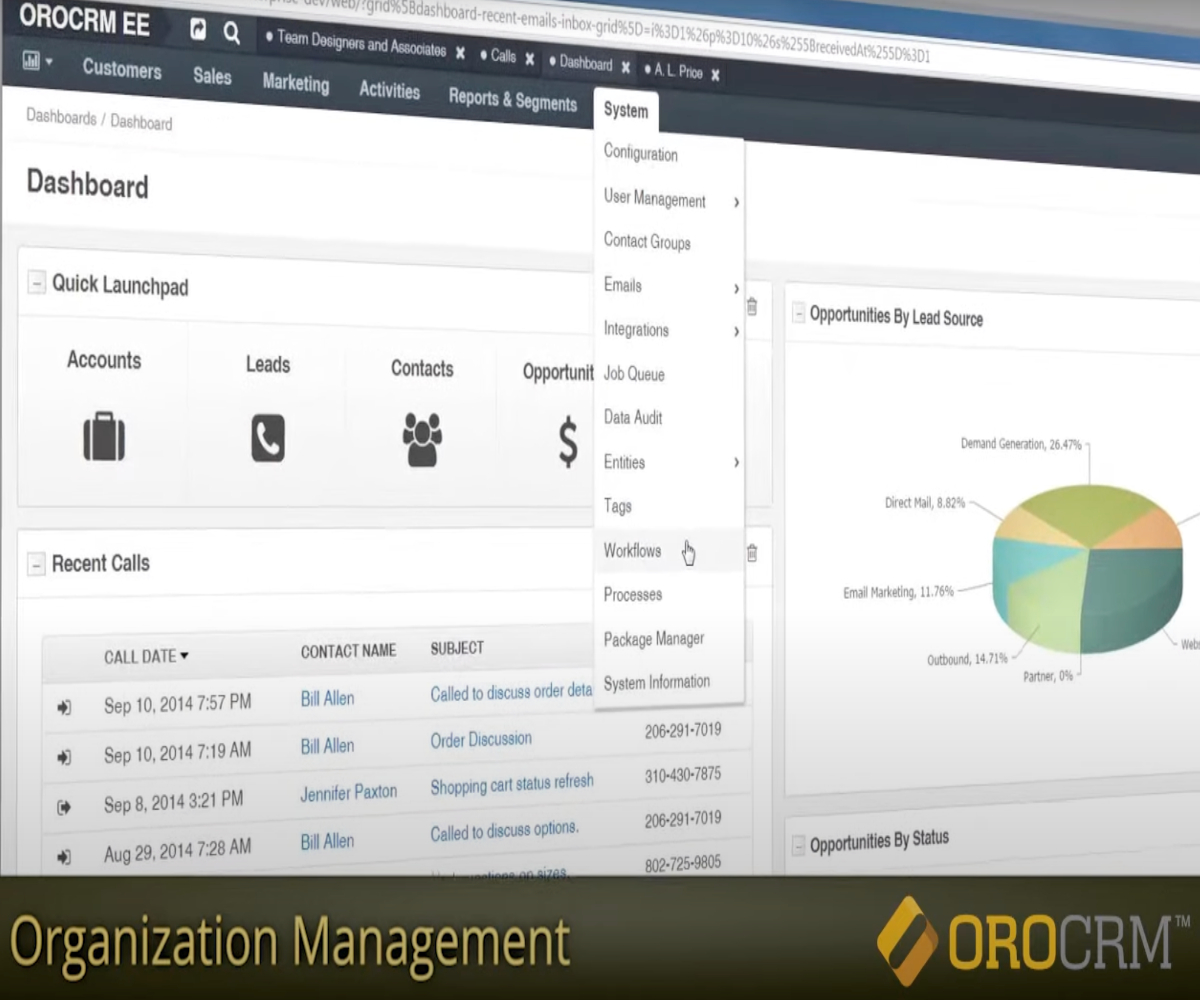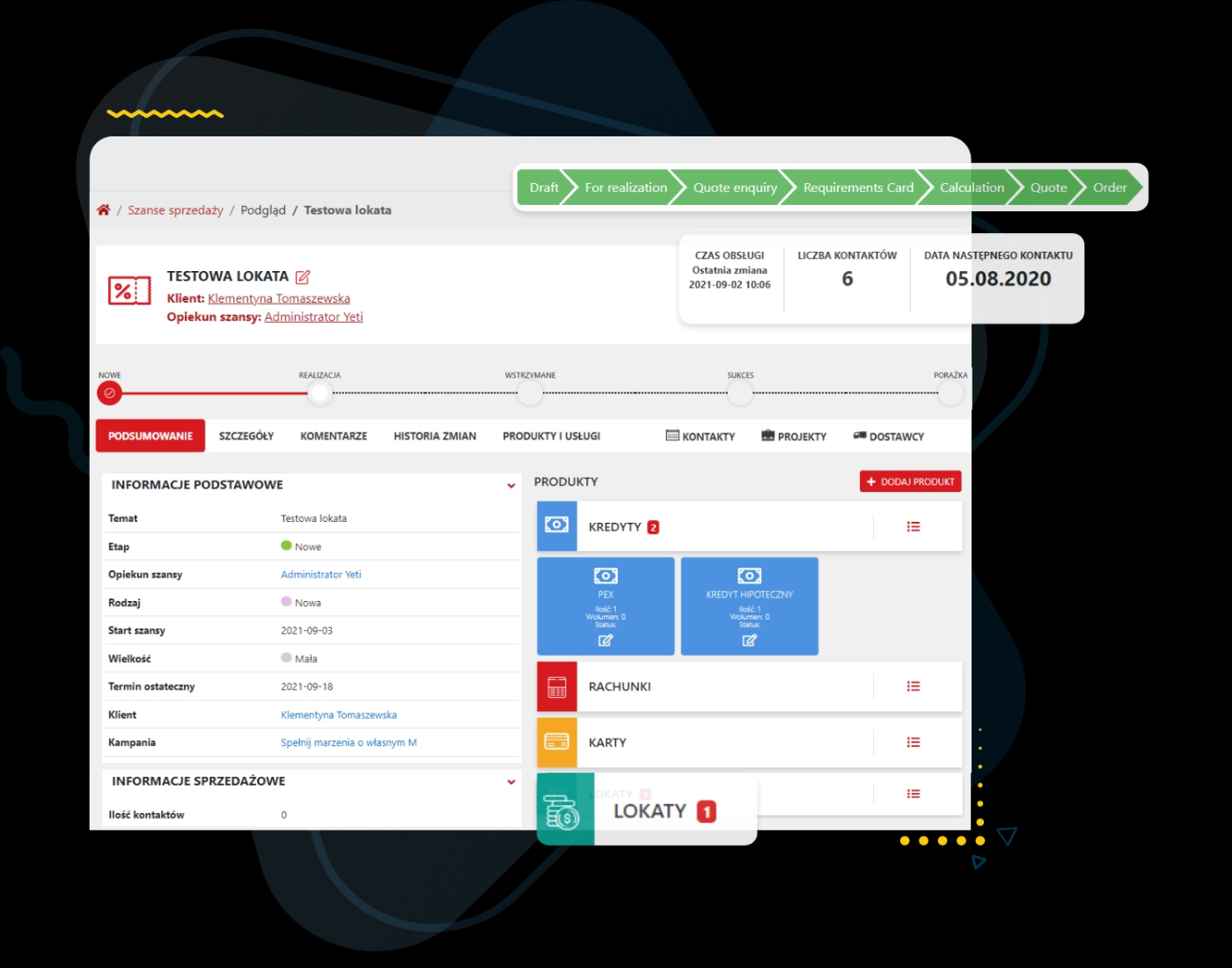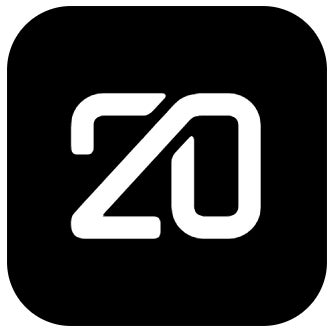- Best overall open-source CRM: SuiteCRM
- Best CRM with open-source CMS tools: HubSpot CRM
- Best for integrating native and third-party apps: Odoo
- Best open-source CRM supporting e-commerce: OroCRM
- Best open-source CRM for international clients: YetiForce
- Best CRM to deploy on cloud or on-premise: Twenty
Open-source CRM software is any CRM with the niche functionality of allowing its source code to be publicly available for any user to make changes or customizations to it. Organizations that choose open-source software over closed-source are typically capable of advanced tech coding and want the benefits of being able to customize their platform at an affordable price.
Top open-source CRM software comparison
Open-source CRMs are downloadable software that users can code to fit their specific needs. The best open-source CRM software offers modern API for coding, vast scalability, and both preset and customizable modules to manage pipelines and data. The options I compare below also offer subscription-based hosted CRMs that come with standard features and tools already built into the platform.
| Software | Pipeline management | Mobile app | Cloud-based platform | Built-in reporting tool | Open-source pricing* |
|---|---|---|---|---|---|
| SuiteCRM | Yes | Yes | No | Yes | Free |
| HubSpot CRM | Yes | Yes | Yes | Yes | Free |
| Odoo | Yes | Yes | Yes | Yes | Free |
| OroCRM | Yes | No | Yes | Yes | Free |
| YetiForce | Yes | Yes | Yes | Limited | Free with add-ons |
| Twenty | Yes | No | Yes | Limited | Free |
| *Cost to download basic open-source platform | |||||
DOWNLOAD: This CRM feature comparison from TechRepublic Premium
SuiteCRM: Best overall open-source CRM

SuiteCRM is a great all-in-one open-source CRM that prioritizes giving users a 360-degree view of their customers and business as a whole. SuiteCRM supports various features that can be customized with sales, case management, workflow, and configuration tools. SuiteCRM’s open-source capabilities make sure users with technical expertise and community support can adapt their features to build out entire sales processes from start to finish.
Why I chose SuiteCRM
Suite CRM is a popular open-source CRM with almost 2 million downloads and 5 million users. The tool offers advanced customizations while prioritizing building out that 360-degree view of the customers. The provider provides unique solutions that focus on helping users build relationships, increase sales, engage customers, and improve customer satisfaction.
While Suite CRM’s free trial is longer than the industry standard, user reports of an outdated platform interface are common. If you want a modern but easy-to-navigate platform, look into HubSpot.
Pricing
- Open source community tier: Free to download.
- SuiteAssured: Hosting platform, contact for quote.
Features
- Configuration studio: Add new fields, customize layouts, and create new modules with their system admin tools.
- Activity management: Automate and track touchpoints with clients with their calls, meetings, tasks, and notes modules.
- Report module: Build, auto-generate, and schedule reports based on real-time data from any module within the CRM.

SuiteCRM pros and cons
| Pros | Cons |
|---|---|
| 30-day free trial. | Users report outdated UI/UX. |
| Software demo. | No customer support via phone. |
| Multiple industry expertise. | Users report invoicing errors. |
Features
- Lead prospecting: Manage incoming leads and sales opportunities from one personalized prospecting workspace.
- HubSpot AI: Use AI-powered tools to create sales and marketing material.
- Email templates: Create templates from effective sales emails to share with a team.

HubSpot pros and cons
| Pros | Cons |
|---|---|
| Variety of integrations. | Costly higher support tiers. |
| Reports of a simple user interface. | No free trial. |
| 24/7 support via chat. | Add-ons start at $25 per month. |
Odoo: Best for integrating native and third-party apps

Odoo’s open-source development offers a broad range of applications that can be integrated into one tool. This can be cost-effective, especially since organizations don’t need to purchase multiple unconnected platforms. Odoo’s free version only allows one app download, though it does come with unlimited users. Only having access to one license may pose difficulties depending on your CRM’s need.
The standard and custom tiers allow access to thousands of finance, sales, marketing, HR, inventory, and productivity tracking applications.
Why I chose Odoo
Odoo is a customer-centric CRM for sales teams. The platform gives users a bird’s-eye, kanban view of all sales pipelines for maximum efficiency. Uniquely, Odoo can also run as a point-of-sales tool for in-person commercial shops and restaurants. Other industry specializations include finance and human resources.
As mentioned above, Odoo’s free download might limit you to accessing only one application. If you want a robust free option, I’d recommend considering SuiteCRM or HubSpot.
Pricing
- Community open source: Free to download.
- Enterprise hosting: Contact for quote.
- One app tier: One app download for unlimited users.
- Standard tier: $24.90 per monthly user for unlimited apps through Odoo online.
- Custom tier: $37.40 per monthly user for unlimited apps through Odoo online, on-premise.
Features
- Lead mining: Generate new leads that match an ideal customer profile and merge them into an Odoo database.
- Assignation rules: Define unique rules and triggers to assign and route leads to specific sales teams or individual reps.
- 360-degree visibility: Uncover what pages leads have visited on a website, what emails or meetings they engaged in, and more.

Odoo pros and cons
| Pros | Cons |
|---|---|
| Free demo. | Limited reporting and analytics. |
| Unlimited hosting and maintenance for paid plans. | User reports of poor customer support. |
| Community resources and tutorials. | Limited documentation. |
OroCRM: Best open-source CRM supporting e-commerce

OroCRM’s open-source offering makes Oro products more accessible and innovative, especially for B2B e-commerce organizations. This solution helps organizations move online for the first time with a digital channel to support physical locations while maintaining operations by tracking all sales activities. Industries like automotive, industrial parts, and medical supplies can all use this open-source platform to sync digital, marketing, sales, and IT teams in one hub.
Why I chose OroCRM
OroCRM can be used by a single or multi-channel business focused on B2B, B2C, or a combination of both. The open-source CRM software offers flexibility to customize any business’s unique workflow. OroCRM has rich features for optimizing conversions, growing sales, and increasing customer satisfaction.
OroCRM can be a difficult CRM to implement and get off the ground, depending on your team’s expertise. If you want a provider offering unlimited hosting and ongoing platform maintenance, I’d check out Odoo.
Pricing
- Open source: Free to download.
- OroCloud hosting: Contact for quote.
Features
- Recency, frequency, and monetary analysis: Identify top customers based on how recently, how often, and how much they spend on purchases.
- Account management: View and manage all accounts, interactions, and information from one dashboard.
- Performance dashboards: Track team and individual performance in segmented campaigns or opportunity close rates with workflows.

OroCRM pros and cons
| Pros | Cons |
|---|---|
| User-driven security. | Over 25 admin users cost extra. |
| Offers a free demo. | No mobile application. |
| Integrations. | User reports of a learning curve. |
YetiForce: Best open-source CRM for international clients

YetiForce offers an easy five-step process for downloading and registering their open-source CRM. This includes access to documentation on how to configure the functionalities available on the system properly and granting access and language settings. YetiForce has 80 ready-to-use modules that can be freely configured in their modern API. Its sales, marketing, support, and logistics tools support users from across the globe in 35+ languages.
Why I chose YetiForce
YetiForce is an adaptable CRM software that can offer solutions for marketing, sales, support, logistics, and more. Users can quickly implement the platform with its unlimited expandability and customization. With over 80 modules, users no longer need paid solutions such as Trello, Slack, Redmine, Asana, or Jira. YetiForce is an open-source software with no restrictions for anyone with any skill set.
While YetiForce can be a powerful tool, there are some limitations with integrations and the overall tenure of the platform. If you want a well-rounded solution with more than 1,500+ integrations, check out HubSpot.
Pricing
- Open source: Free download with paid add-ons.
Features
- TasOnline store: Store all data and analytics simultaneously in a central system controlled through configurations.
- International entry: Access account or client data online from anywhere in the world.
- Customer portal: Exchange data and information directly from a fully integrated portal.

YetiForce pros and cons
| Pros | Cons |
|---|---|
| 300+ deployments. | Limited customer support. |
| 90+ configuration panels. | No lead scoring. |
| In accordance with OWASP ASVS. | No native application. |
Twenty: Best CRM to deploy on cloud or on-premise

Twenty can be deployed on any cloud or on-premise, making it an accessible open-source option for many businesses. Since Twenty is GPL-licensed, users own the software they build on instead of renting it. This way, businesses benefit from the simplicity of a SaaS platform with the freedom and cost savings of open-source solutions.
While installation, configuration, encryption, security, backups, and more can sound intimidating, Twenty offers extensive community resources to help with the deployment and maintenance of the software.
Why I chose Twenty
Twenty is a modern open-source solution that markets itself as data-centric. This means the CRM can be built around your existing data, allowing users to access and visualize any source instead of forcing data to be reconstructed into predefined objects on a remote cloud. It’s a very customizable tool that can be adapted to unique workflows.
While Twenty does allow users to pick up a project exactly where they want to and at whatever stage of completion, it still will take dedicated time to implement successfully. If you want an existing CRM with open-source CMS capabilities, I recommend checking out HubSpot.
Pricing
- Early Adopter: $9 per user per month.
- Self-hosting: Free. This is through Github and is still in the alpha version, so updates are consistent and could be a challenge.
Features
- Tasks: Generate, tag, assign, and check off daily or weekly tasks with easy drag-and-drop tools on a homepage.
- Community roadmaps: Start a community discussion or contribute the code when you notice a missing feature.
- Workspaces: Create workspaces to track opportunities, companies, accounts, and other client firmographics with custom fields and filters.

Twenty pros and cons
| Pros | Cons |
|---|---|
| 7-day refund. | Doesn’t offer features around product catalogs and territory management. |
| It offers resources like community forums, Discord, and user guides. | No live chat support. |
| Powerful GraphQL and API capabilities. | Limited scalability compared to others on this list. |
How do I choose the best open-source CRM software for my business?
The best open-source providers differ from the top generalized CRM. All of the CRM software options on this list offer a free trial and have sales teams to help guide you through their purchasing and onboarding process.
Below are some questions to consider when selecting an open-source CRM:
- What in-market industry specialization does the software have?
- Do their services match your allocated budget for an open-source CRM?
- Does your organization have the technical expertise for its open-source software?
- Does the platform accommodate your small business size and potential growth?
SEE: For more information on CRM benefits and how to implement the platform, check out our piece on how a CRM can help your small business grow.
Benefits of open-source CRM
Choosing to go with an open-source CRM over a more generalized solution can bring several benefits to your business. While they do require more technical expertise and back-end coding knowledge to get the full functionality out of one of these tools, they can also host more customizations, collaboration, and cost efficiencies.
The top three benefits of CRM software that is open source are:
- Cost: Open-source software is typically free or very low in cost compared to proprietary software that is already built out.
- Flexibility: Have complete and total control over how the software integrates with other tools and build custom flows and dashboards.
- Collaboration: Gain access to the knowledge and help from a network of users, developers, and other contributors to build software or troubleshoot problems.
Review methodology
We reviewed and scored each open-source software against an in-house rubric with outlined criteria and subcategories of standard CRM features and offerings. Using that rubric and an algorithm to calculate an overall star rating, we determined each CRM software’s ideal use case.
Here is a breakdown of the scoring criteria we followed:
- Cost: Weighted 25% of the total score.
- Core features: Weighted 25% of the total score.
- Customizations: Weighted 15% of the total score.
- Integrations: Weighted 15% of the total score.
- Ease of use: Weighted 10% of the total score.
- Customer support: Weighted 10% of the total score.
SEE: How we review CRMs
Frequently asked questions (FAQs)
What is open-source CRM software?
Open-source CRM software is a downloadable version of CRM, and its source code is available for users to modify. Users can tailor the CRM platform to meet their specific business needs by downloading the framework of a tool and building customizations on top.
Which is the best open-source CRM?
The best open-source CRM providers include SuiteCRM, Odoo, OroCRM, and others, which I’ve included on this list. While these providers are all great options in their own right, I recommend considering the ideal use cases I’ve provided for each, plus each one’s CRM pricing, key features, pros and cons to identify the best option for your business.
Is there a risk using an open-source CRM?
The biggest risk while using an open-source CRM is the lack of security. Since the code is running open, there is a risk that the data is accessible and easily manipulated. Hackers or unauthorized users can discover vulnerabilities in the open-source system quickly and often before admins can repair and block them. I suggest understanding general CRM best practices, plus how to implement additional security measures.
















Leave a Reply